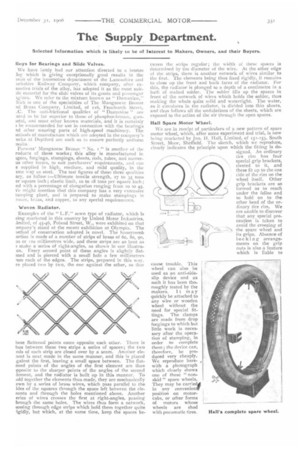The Supply Department.
Page 21

If you've noticed an error in this article please click here to report it so we can fix it.
Selected Information which is likely to be of Interest to Makers, Owners, and their Buyers.
Boys for Bearings and Slide Valves.
We have lately had our attention directed to a bronze loy which is giving exceptionally good results in the suds of the locomotive department of the Lancashire and 'orkshire Railway Company, which company, after exaustive trials of the alloy, has adopted it as the most suitale material for the slide valves of its goods and passenger ig-nes. We refer to the mixture known as " Damaxine," .hich is one of the specialities of The Manganese Bronze rid Brass Company, Limited, of 116, Fenchurch Street, .C. The anti-frictional qualities of " Damaxine " are atcd to be far superior to those of phosphor-bronze, gunietal, and most other known materials, and it is certainly be recommended for use in connection with the bearings ad other wearing parts of high-speed machinery. The tethods of manufacture which are adopted in the company's orks at Deptford are such as to ensure perfectly uniform Parsons' Manganese Bronze " No. i " is another of the roducts of these works; this alloy is manufactured in tgots, forg-ings, stampings, sheets, rods, tubes, and numerus other forms, to suit purchasers' requirements, and eon e supplied in high, medium, and mild quality, in the ime way as steel. The test figures of these three qualities ary, as follow 7—Ultimate tensile strength, 27 to 35 tons er square inch ; elastic limit, to to 18 tons per square inch ; nd with a percentage of elongation ranging from zo to 45.
might mention that this company has a very extensive tamping plant, and is prepared to make stampings in ronze, brass, and copper, to any special requirements.
Woven Radiator.
Examples of the " L.F." sewn type of radiator, which is eing marketed in this country by United Motor Industries, ,muted, of 45-46, Poland Street, W., were exhibited on that 3mpany's stand at the recent exhibition at Olympia. The iethod of construction adopted is novel. The honeycomb ortion is made of a number of strips of brass of 6o, So, go, 30 or 120 millimetres wide, and these strips are so bent as ) make a series of right-angles, as shown in our illustraon. Every second point of these angles is slightly flatmed and is pierced with a small hole a few millimetres .om each of the edges. The strips, prepared in this way, re placed two by two, the one against the other, so that
hese flattened points come opposite each other. There is bus between these two strips a series of spaces; the two rids of each strip are closed over by a seam. Another eleaent is next made in the same manner, and this is placed g-ainst the first, leaving a small space between. The flatened points of the angles of the first element are thus pposite to the sharper points of the angles of the second lenient, and the radiator is built up in this manner. To .old together the elements thus made, they are mechanically ewn by a series of brass wires, which pass parallel to the ides of the squares through the space left between the elenents and through the holes mentioned above. Another eries of wires crosses the first at right-angles, passing hrough the same holes. The wires thus form a network, Passing through edge strips which hold them together quite igidly, but which, at the same time, keep the spaces be tween the strips regular; the width of these spaces is determined by the diameter of the wire. At the other edge of the strips, there is another network of wires similar to the first. The elements being thus fixed rigidly, it remains to close up the front and back faces of the radiator. For this the radiator is plunged to a depth of a centimetre in a bath of melted solder. The solder fills up the spaces in front of the network of wires which holds the solder, thus making the whole quite solid and watertight. The water, as it circulates in the radiator, is divided into thin sheets, and thus follows all the undulations of the sheets, which are exposed to the action of the air through the open spaces.
Hall Spare Motor Wheel.
We Are in receipt of particulars of a new pattern of spare motor Wheel, which, after some experiment and trial, is now heing marketed by Jno. H. Hall, Lierlited, of 151-153, South Street, Moor, Sheffield. The sketch, which we reproduce, clearly indicates the principle upon which the fitting is designed. An ordinary tire rim has four special grip brackets, riveted to it, and these fit up to the one side of the rim on the wheel itself. Other grip brackets are so formed as to reach under the felloe and to hold on to the other bead of the ordinary tire rim. We are unable to discover that any special precaution is taken to avoid the creeping of the spare wheel and its grips. Absence of locking arrange merits on the grip nuts is also a feature which is liable to cause trouble. This wheel can also be used as an anti-sideslip device and as such it has been thoroughly tested by the makers. It may quickly be attached to any wire or wooden wheel without the need for special fittings. The clamps are made from drop forgings to which but little work is necessary after the operation of stamping, in order to complete them ; the device can, therefore, be produced very cheaply. We reproduce herewith a photograph which clearly shows one of these "nonskid " spare wheels. They may be carriedg in any convenient, position on motorcabs, or other forms
of motors whose wheels are shod with pneumatic tires.






















